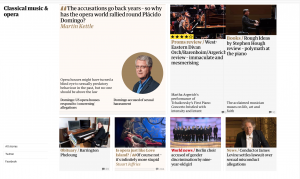This post is written by network member Dr. Penny Brandt.
The Women’s Philharmonic Advocacy has been tracking representation of music by women composers in “regular season ‘Classical’ programs” of the top twenty-one orchestras in the United States for the last three years. Their research reveals a very slight trend upwards in the numbers, which are delineated by different metrics (composer numbers vs. works numbers, for instance) on their website.[1] WPA notes that the numbers would be different if they included non-mainstage performances. “For example, the Los Angeles Philharmonic has a fantastic new music series titled Green Umbrella . . . [with] many exciting new commissions by contemporary women.” Similarly, the Seattle and National Symphony Orchestras are presenting music by women in “Family Concerts.” The trend of including women in non-mainstage programming is not exclusive to orchestras. The Metropolitan Opera of New York announced last year that it will be working with composer Missy Mazzoli, but added that the company will “venture beyond the walls of its opera house to collaborate with the Brooklyn Academy of Music and the Public Theater” — an admission that the Met Opera production of Mazzoli’s chamber opera is slated to take place outside of Lincoln Center.[2]
In his 2005 Oxford History of Western Music, Richard Taruskin recommends the practice of “mainstreaming” — an activist practice of including lesser-known works by women composers in order to advance the political and social causes of women in present times.[3] He credits this practice for his inclusion of a cantata by Barbara Strozzi (1619–1677) in his History of Western Music in lieu of one by “the more famous and prolific [Giacomo] Carissimi” (1605–1674), with the hope that “mainstreaming may constructively counteract the unfounded assumption that women are lacking in innate capacity to compose.”[4] Many scholars (particularly the so-called “new musicologists” of the latter half of the twentieth century) have worked to identify the ways in which our aesthetic sensibilities have generated an exclusive canon full of “dead white men in wigs.”[5] Taruskin correctly identifies ways in which our societal concept of “greatness” is closely aligned with maleness, but while we can applaud his decision to “mainstream” women into his textbooks in 2005, we can also see the damage done when he framed his decision as a choice with the goal of performing activism and by immediately comparing Strozzi to Carissimi.
Artistic Directors and scholars must take care that they do not undo their own activism in the course of executing diversity initiatives. Advocates and allies for inclusion in music negate their own efforts when they tokenize and “other” composers through clumsy programming and marketing efforts. If music organizations want audiences to embrace diversity in programming, they cannot apologize for inclusion of composers from historically underrepresented groups by over-justifying their decisions or by relegating their music to lesser spaces. How can anyone expect audiences to believe there is great music by composers from historically underrepresented groups if audiences never see these composers programmed in series a titled “Masterworks” or “The Great Classics”?
The Institute for Composer Diversity, in addition to its award-winning database of composers and their music, offers resources for “Best Practices” in programming for inclusion and diversity. Utilizing these resources can help groups to avoid a misfire that inadvertently reinforces the canon. These resources are available on the Institute for Composer Diversity’s “Best Practices” page.
Notes
[1] “2019-2020 Season: By the Numbers” at Women’s Philharmonic Advocacy Blog. Accessed November 29, 2019 at https://wophil.org/2019-2020-season-by-the-numbers/?doing_wp_cron=1560916321.2888329029083251953125
[2] “The Met Is Creating New Operas (Including Its First by Women)” in The New York Times. Accessed November 29, 2019 at https://www.nytimes.com/2018/09/23/arts/music/metropolitan-opera-bam-public-theater-women.html
[3] Richard Taruskin, The Oxford History of Western Music, vol. 2, Music in the Seventeenth and Eighteenth Centuries (New York: Oxford University Press, 2010), 78.
[4] Ibid.
[5] Sophie Fuller, “Dead White Men in Wigs: Women and Classical Music,” in Girls! Girls! Girls! : essays on women and music, ed. Sarah Cooper (New York: New York University Press, 1996).
Dr. Penny Brandt is Adjunct Lecturer in Musicology at the Butler School of Music, University of Texas at Austin, the Artistic Director of the Women Composers Festival of Hartford, and a freelance musician, scholar, and writer.


